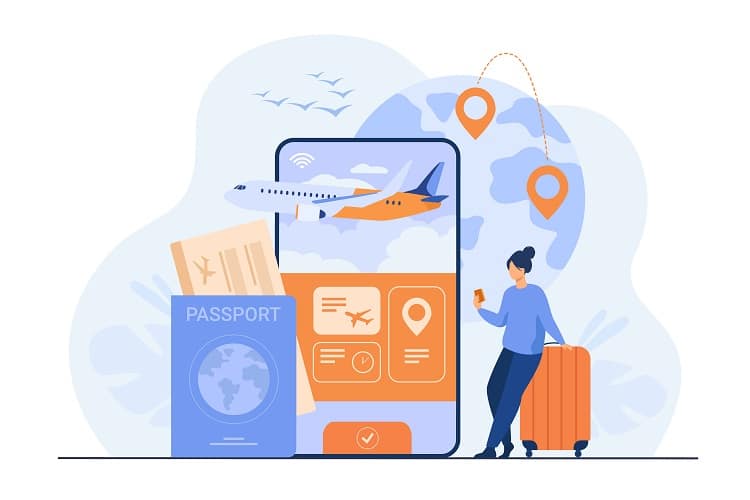So, you said you were planning an exciting adventure abroad? Perfect. I bet you can relate to this scenario:
- Booking the hotel? Checked.
- Buying tickets? Checked.
- Creating the travel checklist?
I know; the checklist is an essential part of international travel preparations… but c’mmon, it’s also such a daunting task! It requires checking all boxes, from documents to your wardrobe.
Luckily, I did this work for you.
Just joking; I’m not crazy, and I didn’t list all *your* items that *you* should take on your trip. But I created a detailed checklist that covers and discuss all international travel essentials.
So – get ready for a hassle-free voyage!
Table of Contents
ToggleStep 1: Prepare your documents

What’s the cornerstone of every foreign trip?
No, not the wine supply. Rather it’s the proper identification. When getting ready for my journey, I always consider taking those documents:
- Passport. The essential. As a U.S. citizen, your just must have this document on hand for any travel in or out of the United States. Just ensure it’s valid for at least six months after your return home and has enough blank pages (some specific destinations require that). Also, check the expiration date in advance. Pay special attention to your children’s passports, which are valid only for five years. Remember to have a valid passport photograph when applying for or renewing your passport because it’s one of the main reasons for passport application rejections.
- Visas. The extra thing. Some countries require access for entry. Check the Visa Quick Check and the embassy website of your destination, so you’ll get more information.
- Vaccination certificate. Regarding COVID-19 certifications, they are not required in most countries already. However, it’s crucial to consider specific vaccines when traveling to areas outside of Western Europe, North America, Australia, and New Zealand.
Here’s the top advice I’ve learned from my traveling friends: plan ahead! Some vaccinations take up to eight weeks (!) to become effective. - Children: the letter of consent. Take note, parents! If you’re traveling with a child as the only custodial parent, a consent letter is necessary. It should state, “I acknowledge that my son/daughter is traveling outside the country with [the name of the adult] with my permission.”, and be signed by the other parent or both parents.
- International Driving Permit. I’m sure you want to avoid complications when renting a car abroad. So, remember to check if your U.S. driver’s license is valid and authorized in the destination country. In any case, the most proven solution is just obtaining an International Driving Permit (IDP). It will save you from any potential issues.
Now, congratulations! You’ve completed the most crucial and demanding step of the international travel checklist: gathering your documents.
Let’s move on.
Step 2: Check the currency and money-related issues
International travel comes with exotic attractions and the chance to savor foreign cuisine… But it all comes at a price. During my foreign trips, I’ve learned how crucial it is to ensure smooth financial transactions. Let me share some tricks.
Before embarking on your journey, notify your bank and credit card companies about your travel plans. It’s the most simple and effective method of avoiding trouble.
In this case, you’re the one who takes the initiative, and you can avert the potential flagging of your accounts for fraud detection. Therefore, it ensures uninterrupted usage of your credit and debit cards.
Another key issue is the local currency. Become familiar with it. The first time I heard this advice, I thought it was about recognizing pictures on currency notes… But no, it’s not the thing.
ignore pictures and check exchange rates. Also, determine the best payment methods at your destination. Cash is more widely accepted in some countries, while others favor card payments. Understanding this will help you estimate how much foreign currency you need to exchange.
Following these points will ensure more than just financial security. You’ll have the means to cover your travel expenses!
Step 3: Review local laws and regulations
Did you know taking selfies with Buddha statues is prohibited in Sri Lanka? Or that wearing high heels is banned in specific historical sites in Greece?
Foreign countries can surprise you not only with their rich culture but also with unique laws. Add reviewing local regulations to your international travel checklist, focusing on the following:
- Medications. Believe me, you don’t want trouble because of your prescription medicaments! Certain narcotics and over-the-counter drugs may be lawful in the United States but prohibited in other countries. It’s definitely worth checking before flying.
- Road safety. Simply getting the IDP is not enough. Every time I rent a car abroad, I learn about the specific road safety rules of this country. I don’t want to be perceived as a road maniac or be ticketed.
- Insurance. Ensure your U.S. health insurance covers you while abroad. I see that many overseas medical institutions do not accept U.S. insurance and require upfront cash payments.
Step 4: Prepare for emergencies

Travel is a thrilling adventure, right? By its nature, it involves a certain level of risk. Even if you plan a trip to de-stress, it is essential to be fully prepared for potential emergencies.
Firstly, *always* have a plan B.
I’ve learned from my experience not to rely solely on the resources and assistance of the U.S. government. I like to give thought to alternative evacuation options, like purchasing emergency evacuation insurance. It’s especially important you’re engaging in extreme activities or visiting high-risk areas.
Secondly, check medical recommendations.
Your destination country might not require specific vaccinations, but *suggest* them. From my experience, it’s worth checking. The health is worth some effort, and all you need to do is to review the list of recommended vaccinations on the WHO’s website. It provides up-to-date information on health recommendations for different countries.
Both above points are vital, but I hope you won’t need to apply them during your trip!
Step 5: Learn about your destination
Thankfully, travel preparations are not solely focused on laws, documents, and requirements.
For me, the most exciting part is learning about my travel destination. I love this thrill when checking places I’m going to see and reading about the people I’ll meet there. In addition to fueling positive emotions before I set out, it benefits the journey.
Here are a few examples of why does it pay off.
- The weather. In Saudi Arabia, evenings can get chilly as most of the heat in the sand dissipates quickly. Additionally, humidity affects the perceived temperature. Without knowing it, you can simply freeze up. So, besides checking the weather forecast, research the weather patterns to ensure you’ll feel comfortable with your clothing.
- The local culture. Did you know that the left hand is considered unclean in some areas? I mean the Middle East, Sri Lanka, and India, to name a few. Using it for eating or other activities can be perceived as insulting. Some cultural faux pas have taught me it’s worth learning about such customs before the journey.
- Electrical converters and adapters. It’s the practical one. Voltage and plug types vary among countries. Keep charged! Don’t forget to check the voltage and plug types of your destination country. Then, take the right electrical converters and adapters to power your electronic devices.
Step 6: Keep up with news and safety updates
This step is the long-time one. It requires regular attention and updates. Why? Because it’s all about staying in the curve with the local situation.
It’s crazy how much can change between ticket booking and the day you’re set to leave. Don’t fall into that trap; stay in the loop about any weather updates, local happenings, or festival announcements. It’s the best way to adapt your travel plans accordingly.
Additionally, regularly read the Travel Advisory and Alerts for the countries you’ll visit on travel.state.gov/destination. Any experienced traveler will tell you that: there’s no better way to stay safe and well-informed during your journey.
Step 7: Verify your itinerary and other travel details
This checklist point is your peace-of-mind saver.
Have you ever experienced that sinking feeling when you realize you’ve mistaken your departure time? So you know what I’m talking about. Many such unpleasant mistakes have shaped me into a perfect habit of double-checking.
Regarding flights, verify the carry-on and luggage restrictions imposed by your airline. One time, I forgot that they can vary among different carriers and change, and I got some luggage trouble at the airport. It was a harsh lesson about double-checking the airlines’ requirements in advance. Also, it’s worth reviewing the latest security measures and the list of prohibited items on flights on the Transportation Security Administration’s website.
Even more important is to verify all your travel details. Do it carefully. Start with arrival and departure dates, then move on to all your reservations and bus numbers.
Believe me or not, it will save a lot of stress during your trip.
Step 8: Create Your Packing List
Does the universal packing list exist?
I highly doubt it.
Your travel duration, preferred activities, and destination all play a role in shaping the contents of your suitcase. So, does it make sense to rely on a ready-made list? Not really.
But it makes sense to review if it includes some practical and often overlooked items:
- printing copies of your reservations, confirmations, and tickets
- portable charger
- earplugs, eye mask, and sleeping pills
- electrical converters and adapters
- antibacterial wipes
- sweater or scarf because the plane is often chilly
And, of course, remember your documents and wallet! These are the essentials that will truly make or break your trip.
Step 9: Cover your home base
The best journey takes you home.
Do you agree?
Making sure your house is protected can give you peace of mind while you’re away. So, consider securing your home base before setting off.
Firstly, hold your mail. An overfilled mailbox is a sure sign that nobody is home. The simple trick is to request your local post office to hold your mail until you return. It helps avoid drawing attention and potential risks.
Secondly, consider hiring a trustworthy house sitter or asking a responsible neighbor for help. Having someone present in your home can deter potential burglars. Plus, if you have pets, your furry friends will appreciate the company!
Finally, keep your family and friends updated about your travel plans. It’s just more safe when someone back home knows where you are. Also, inform your closest ones how to get in touch with you when you are abroad, so they can reach out to you if needed.
Then – bon voyage!
Wrapping it up
Well, did you uncover the trick for a hassle-free vacation?
Preparation, preparation, and more preparation! With the international travel checklist in hand, you can confidently check off each step and maintain a firm grip on the entire process.
Hey, if you think there’s a step missing or have some travel wisdom to share, don’t hold back! Let’s learn from each other and make future adventure travels even smoother.
Safe travels, fellow explorers!


